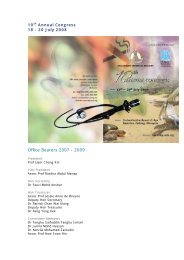download - Malaysian Thoracic Society
download - Malaysian Thoracic Society
download - Malaysian Thoracic Society
Create successful ePaper yourself
Turn your PDF publications into a flip-book with our unique Google optimized e-Paper software.
Annual Congress of <strong>Malaysian</strong> <strong>Thoracic</strong> <strong>Society</strong><br />
PP 5<br />
An Age-Structured Mathematical Tuberculosis Transmission Model<br />
As Tool For Outbreak Modelling And Control In Malaysia<br />
Nurhuda Ismail 1, 2 , Awang M Bulgiba 2 , Nicolaas J D Nagelkerke 3 , Omar Awang 2<br />
1<br />
University of Technology MARA Sungai Buluh Campus, Selangor, Malaysia<br />
2<br />
University of Malaya, Kuala Lumpur, Malaysia<br />
3<br />
United Arab Emirates University, Al-Ain, United Arab Emirates<br />
Infectious diseases such as HIV/AIDS, tuberculosis and dengue continue to be public health threats in<br />
Malaysia. The burden on infectious diseases is increasing with new emerging diseases such as SARS and<br />
H1N1. With current lack of response, human capacity and resources, as well as serious adverse effects<br />
on probable promising interventions, we seek to find if applications of mathematical modelling in infectious<br />
disease outbreak modelling and control would complement the current conventional epidemiological and<br />
interventional studies resulting in greater impact on reducing incidence. Our study aims to develop an agestructured<br />
tuberculosis model and subsequently apply the use of infectious disease modelling to study the<br />
progression of latent tuberculosis infection, and to assess the impact of current and possible interventions on<br />
reducing incidence. We review tuberculosis pathophysiology and its transmission dynamic that best reflects<br />
reality at present which includes primary infection, endogenous reactivation and exogenous reinfection using<br />
deterministic compartmental models with SEIR structure and the ordinary differential equation system. We<br />
take into account its unique characteristics on heterogeneity, age and gender. A deterministic compartmental<br />
age-structured tuberculosis model is developed. Model equilibria and stabilities are reached and analyzed.<br />
Model fitting, probabilistic sensitivity testing and uncertainty analysis are performed. Epidemic thresholds<br />
known as reproduction numbers for the model are determined. This tuberculosis model best fits the <strong>Malaysian</strong><br />
environment and characteristics may be used further for outbreak modelling and control simulations, as well<br />
as for disease and economic burden estimates and prediction. Its comparability and reliability is further<br />
discussed.<br />
67








